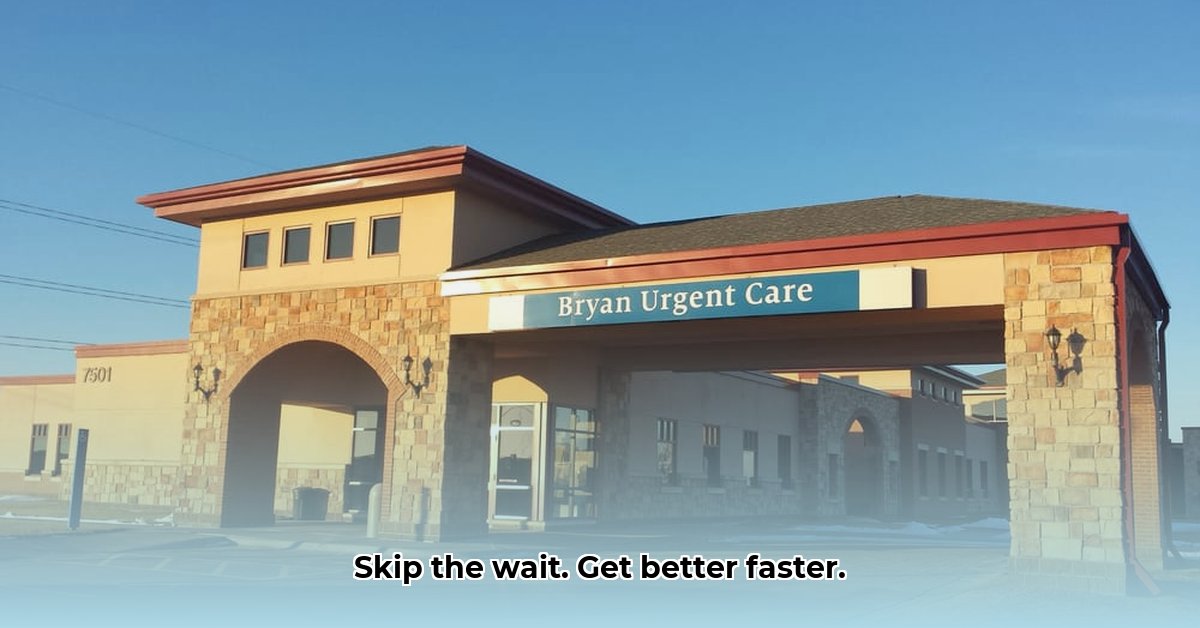
Understanding Urgent Care: A Convenient Healthcare Option
Feeling unwell but unsure where to turn? Urgent care clinics, like Bryan Walk-in Clinic, offer a convenient alternative to emergency rooms and lengthy doctor's appointments for non-life-threatening conditions. This guide explains when urgent care is the right choice, how to make the most of your visit, and how to choose the best facility for your needs.
The Benefits of Urgent Care
Urgent care centers provide faster access to medical attention compared to traditional doctor's offices. Many operate on a walk-in basis, eliminating the need for appointments and reducing wait times. Their extended hours, often including weekends and holidays, offer greater flexibility for busy individuals. This convenience is a significant advantage, especially for unexpected illnesses or injuries. Think of it as a convenient healthcare “pit stop” for your immediate needs. However, it's important to remember that speed doesn't compromise quality; urgent care clinics are staffed with qualified medical professionals ready to provide comprehensive care.
But what about cost? While exact pricing varies, urgent care typically offers a more affordable alternative to emergency room visits for non-life-threatening conditions. This cost-effectiveness coupled with convenience makes urgent care an attractive option for many. Is it always the most economical choice? Not necessarily, but it frequently offers a better balance between cost and speed of care compared to visiting an ER.
When to Seek Urgent Care vs. Other Healthcare Options
Urgent care is ideal for non-life-threatening conditions such as minor cuts requiring stitches, sprains, fevers, mild illnesses, and similar ailments. These facilities are well-equipped to handle such issues efficiently and effectively. However, urgent care is not a substitute for emergency medical services. Serious conditions like chest pain, severe bleeding, or difficulty breathing require immediate attention at a hospital's emergency room. When in doubt, always prioritize your safety and seek emergency care.
To decide whether urgent care is appropriate, ask yourself: "Is this a true emergency requiring immediate, potentially life-saving intervention, or can I safely wait for less urgent treatment?" This simple self-assessment is your first step toward making the right choice.
A clear understanding of the varying levels of care – primary care for preventative and long-term management, urgent care for non-life-threatening but immediate issues, and emergency rooms for life threatening situations – ensures patients are treated appropriately, relieving undue pressure on emergency services.
Your Visit to Bryan Walk-in Clinic: A Step-by-Step Guide
To ensure a smooth and efficient visit, familiarize yourself with the typical process at Bryan Walk-in Clinic or any similar facility:
- Check-in: Register at the front desk. Many clinics offer online check-in, reducing wait times.
- Triage: A medical professional will assess your condition based on your symptoms and medical history.
- Treatment: A doctor or physician's assistant will conduct an examination, order tests (if needed), and provide diagnosis and treatment.
- Checkout: After treatment, you'll receive instructions for follow-up care, prescriptions, and billing information.
This structured approach facilitates efficient care and minimizes any potential confusion. Planning ahead – checking wait times online, gathering necessary medical information, and understanding your insurance coverage– will further optimize your experience.
Choosing the Right Urgent Care Clinic
Selecting the appropriate urgent care clinic requires careful consideration. You wouldn't use a hammer to screw in a screw, so choosing the right facility for your specific needs is equally important. Here’s how to select wisely:
- Online reviews: Research patient reviews to gauge the clinic's reputation and identify any recurring issues.
- Services offered: Ensure the clinic provides the specific services you require.
- Location and accessibility: Select a clinic conveniently located and easy to reach given your condition.
- Wait times: Check for estimated wait times online to plan your visit accordingly.
- Insurance coverage: Verify your insurance coverage before your visit to avoid unexpected costs.
By thoroughly evaluating these aspects, you can increase the likelihood of a positive and effective experience with the selected urgent care facility.
Key Takeaways:
- Understanding the distinctions between primary care, urgent care, and emergency rooms is essential for efficient healthcare navigation.
- The choice of healthcare setting hinges on the severity and urgency of your health issue.
- Wait times and costs significantly vary across these options. Urgent care commonly offers a faster, often more affordable alternative for non-life-threatening illnesses.
- Patient education and better system navigation are crucial for appropriate care-seeking behaviour and alleviating pressure on emergency departments.
Remember, Bryan Walk-in Clinic and similar urgent care facilities serve as vital components of a comprehensive healthcare system, providing readily accessible treatment for a wide range of non-life-threatening conditions. A well-informed approach, coupled with careful planning, will ensure that you receive timely and effective medical attention when you need it most.